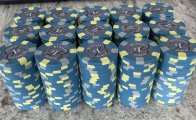For my 800th (ish) post I wanted to give a little back, so thought I'd share some of my talents and tools to create a bit of a reference for anyone designing custom CPC chips.
I'll put this next part in bold so it does not get missed...
This is only a reference. This is not a substitute for manually matching colours through print samples, trial and error and more trial and error. This is close, but not exact. The variables in printing materials, colour mixing and as I understand mold choice can all create variation. This is an estimate.
You will be mostly fine matching a font or design element to the base colour. Even if you are a little off the white in between will be enough to trick the eye. That said, the simple fact is even if you know EXACTLY what colour you need, sometimes the CMYK gamut cannot reproduce it exactly. I could go on and on about it, but basically to get 90% of the way there isn't that hard, to get to 100% is where you really spend your time.
These samples I used for this were delivered in January of 2020, on the A-Mold, and scanned with my Nix Colour Sensor. A PDF Reference is also attached. You can convert to RGB or other colour tools here for on screen viewing. https://www.nixsensor.com/free-color-converter/
With those disclaimers out of the way:
I'll put this next part in bold so it does not get missed...
This is only a reference. This is not a substitute for manually matching colours through print samples, trial and error and more trial and error. This is close, but not exact. The variables in printing materials, colour mixing and as I understand mold choice can all create variation. This is an estimate.
You will be mostly fine matching a font or design element to the base colour. Even if you are a little off the white in between will be enough to trick the eye. That said, the simple fact is even if you know EXACTLY what colour you need, sometimes the CMYK gamut cannot reproduce it exactly. I could go on and on about it, but basically to get 90% of the way there isn't that hard, to get to 100% is where you really spend your time.
These samples I used for this were delivered in January of 2020, on the A-Mold, and scanned with my Nix Colour Sensor. A PDF Reference is also attached. You can convert to RGB or other colour tools here for on screen viewing. https://www.nixsensor.com/free-color-converter/
With those disclaimers out of the way:
| Colour | CMYK |
|---|---|
| Black | CMYK: 69%, 64%, 61%, 56% |
| Blue | CMYK: 83%, 65%, 32%, 14% |
| Blurple | CMYK: 84%, 79%, 33%, 20% |
| Bright white | CMYK: 6%, 9%, 15%, 0% |
| Butterscotch | CMYK: 23%, 59%, 98%, 8% |
| Canary | CMYK: 17%, 31%, 79%, 0% |
| Charcoal | CMYK: 65%, 56%, 55%, 31% |
| Chocolate | CMYK: 42%, 70%, 70%, 41% |
| Dark blue | CMYK: 81%, 71%, 46%, 38% |
| Dark green | CMYK: 77%, 50%, 72%, 51% |
| Dayglo arc yellow | CMYK: 0%, 47%, 76%, 0% |
| Dayglo green | CMYK: 59%, 5%, 73%, 0% |
| Dayglo orange | CMYK: 26%, 84%, 83%, 20% |
| Dayglo peach | CMYK: 0%, 61%, 66%, 0% |
| Dayglo peacock | CMYK: 88%, 44%, 12%, 0% |
| Dayglo pink | CMYK: 0%, 79%, 14%, 0% |
| Dayglo Saturn | CMYK: 36%, 29%, 100%, 3% |
| Dayglo tiger | CMYK: 0%, 78%, 62%, 0% |
| Dayglo yellow | CMYK: 20%, 8%, 73%, 0% |
| Green | CMYK: 88%, 33%, 67%, 18% |
| Grey | CMYK: 45%, 28%, 40%, 1% |
| Imperial blue | CMYK: 88%, 47%, 37%, 10% |
| Lavender | CMYK: 58%, 65%, 31%, 9% |
| Light blue | CMYK: 64%, 29%, 32%, 1% |
| Light Chocolate | CMYK: 37%, 62%, 75%, 26% |
| Light green | CMYK: 69%, 14%, 60%, 1% |
| Mandarin red | CMYK: 24%, 92%, 72%, 14% |
| Maroon | CMYK: 53%, 71%, 63%, 54% |
| Orange | CMYK: 21%, 80%, 88%, 11% |
| Pink | CMYK: 24%, 77%, 40%, 3% |
| Purple | CMYK: 72%, 68%, 31%, 12% |
| Red | CMYK: 30%, 88%, 63%, 21% |
| Retro blue | CMYK: 89%, 81%, 38%, 30% |
| Retro green | CMYK: 91%, 42%, 68%, 34% |
| Retro lavender | CMYK: 39%, 74%, 29%, 3% |
| Retro red | CMYK: 26%, 92%, 58%, 12% |
| White | CMYK: 14%, 15%, 22%, 0% |
| Yellow | CMYK: 25%, 42%, 100%, 4% |



